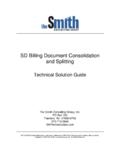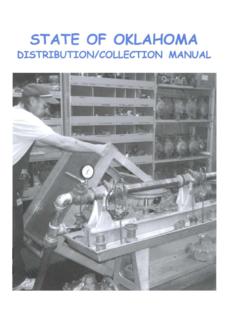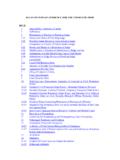Transcription of VOFM ROUTINES IN SALES & DISTRIBUTION
1 vofm ROUTINES IN SALES & DISTRIBUTIONPART 1: COPYING REQUIREMENTSPRODUCT REQUIREMENTS PLANNINGVer sion il 1999 Page 2 Product Requirements PlanningVersion of Contents1. Creating a New vofm Copying Billing 3 Product Requirements PlanningVersion Introduction Transaction vofm is a tool that was developed in R/3 to facilitate the definition of both SAP delivered as well as customer defined ROUTINES / rules used in the system during various business processes. vofm ROUTINES are ABAP code written in Forms. vofm provides the user with the benefit of choosing from one of the standard delivered R/3 ROUTINES or writing their own. vofm is intended for the implementation team when configuring the system.
2 It is not intended for the end is divided up into four main areas. These include copying requirements, data transfer, requirements, and formulas. This paper will focus on copy requirements that were delivered by SAP to support the SALES & DISTRIBUTION (SD) and Logistics Execution (LES) applications. Copying requirements are ROUTINES that check certain requirements as a precondition for the copying process. For example, a copy requirement can be used to define whether a quotation may be copied into a standard order, or if text items are transferred during the copying of a delivery into a billing document. Copy requirements are an easy way to implement company specific business rules into R/3 that dictate situations that should prevent subsequent document creation.
3 Section 2 defines how to create a new vofm routine, in the event that the standard ROUTINES do not match the user needs. In the remaining sections, the SAP standard delivered vofm ROUTINES related to SALES & DISTRIBUTION and Logistics Execution are documented. Starting with Release , this documentation is part of the standard product. This paper assumes that the reader has a general understanding of the SD and LES modules in R/3. 2. Creating a New vofm Copying RequirementIn each area of vofm , SAP delivers ROUTINES using the name space from 1 to 599. SAP customers can create their own vofm ROUTINES using the name space from 600 to 999.
4 To create a new routine, follow these check to see whether you can use one of the copy requirements delivered in the standard overwrite an existing requirement or enter a new number on a new line from the customer name space 600 to 999. Also enter a short description of your copy your copy requirement in the ABAP the the application if you want to use the copy requirement in one particular application area. For example, you have defined a new copy requirement that is only relevant for deliveries. your new copy requirement in the appropriate area in customizing. For example, a new order copy requirement would be assigned to the copy rules for SALES documents.
5 As another example, a text copy requirement would be assigned to the access sequence for the text vofm ROUTINES created at a customer site are not overwritten by a software upgrade. Page 4 Product Requirements PlanningVersion OrdersOrder copy requirements are used to define when copying from an order to a subsequent document is permitted. This is done via detailed copy ROUTINES that verify that the characteristics of the reference and target SALES documents are consistent with the definitions of the preconditions that must be present prior to allowing copying. When creating an order with reference to another document, the system reads the assigned copy requirement and verifies that all of the specified conditions are met prior to permitting the order from being created.
6 If the requirement is not met, the user will be issued a message indicating the reason that the order could not be copy requirements are assigned to the copy rules for SALES document type/item category/schedule line category in looking at the code for the standard delivered order copy requirements, or when writing your own, some standard work areas are used. For a list of these work areas refer to the actual code in the examples following is a description of the copy requirements delivered in the standard system related to COPYING REQUIREMENT 1: HEADER-SAME CUSTOMER In this requirement, the sold-to must be the same in the reference and the target documents, in order for copying to be permitted.
7 In addition, the SALES area must be identical. Additional checks are also performed and the user is issued messages based on the following attributes of the reference document in comparison to the target: completeness, reference percentage, currency, validity dates, and the payment plan. Example:If in your company, there are special products that can only be sold to special customers ( Government), then it makes sense to forbid the copying of SALES documents from one customer to another. If this is the case in your company, the accidental copying of documents from differentcustomers can be prevented by implementing this copying requirement.
8 ORDERS COPYING REQUIREMENT 2: HEADER-DIFFERENT CUSTOMER In this requirement, if the sold-to is different in the reference and the target documents, the user receives a warning message, but copying is still permitted. The SALES area must be identical, however, in both documents in order for the requirement to be met. Additional checks are also performed and the user is issued messages based on the following attributes of the reference document in comparison to the target: completeness, reference percentage, currency, validity dates, and the payment plan. Example:In many companies, copying of documents is permitted from one customer's document to a document for a different customer.
9 However, if there are special customer material numbers used by the reference document customer, it is advisable to issue a message to the user indicating that the Page 5 Product Requirements PlanningVersion in the documents are different so that the user can make the decision to abort the copy, or to manually make the adjustments to the document to reflect the differences. If this routine is assigned to the document type, these warning messages will be issued automatically when the customers are COPYING REQUIREMENT 21: BILLING HEADERIn this requirement, there must be a valid division in the billing header. In addition, the following fields must match exactly in the source and the target document: sold-to party, SALES area, and currency.
10 Additional checks are also performed against the payment plan type and the user is issued a warning message if the source and target plans are different. Example:In order to permit the creation of credit memo requests with reference to a billing document, certain checks must be performed to insure that the two documents are consistent. This requirement can be used to insure that these checks are performed. ORDERS COPYING REQUIREMENT 301: ITEM REJ ECTION REASONIn this requirement, all lines that have a reason for rejection are not copied into the target document. Example:A SALES order is created for a customer that will later be replicated for all of their branch offices.







